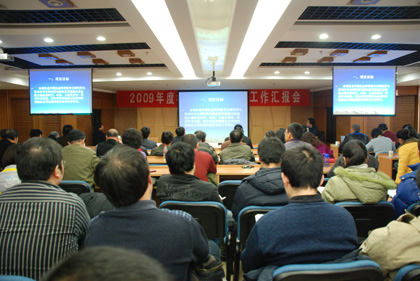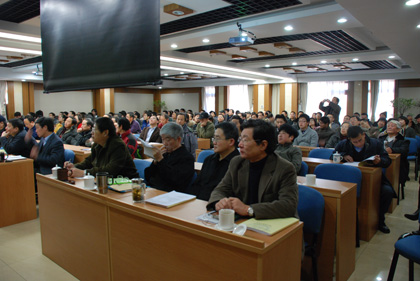The Institute of Archaeology (CASS) Holds 2009 Annual Field Archaeology Conference
The Chinese Academy of Social Sciences' Institute of Archaeology (IA CASS) held its annual Field Archaeology Conference 2009 on January 12, 2010. The conference took place in the conference room on the 8th floor of the Institute and was presided over by Deputy Director Professor Chen Xingcan. During the conference, scholars presented reports on thirteen archaeological excavations conducted in 2009.

The conference began with a report by Jia Xiaobing, an Associate Research Fellow from the Department of Prehistoric Archaeology, on the excavation of the Xiaozhushan shell mound site in Liaoning's Changhai County. The purpose of the excavation of this Neolithic site was to further the research into the Neolithic cultures of the Liaodong Peninsula and to better understand the developmental sequence and ancestry of the various Neolithic cultures which inhabited the region. Other issues investigated include the emergence of agriculture in the Liaodong Peninsula, the relationship between the agricultural and the fishing-hunting economies, and the relationship between the means of livelihood and the palaeoenvironment of the Neolithic period.
Mr Jia's report was followed by a report by Professor Wang Jihuai, on the Anhui Fieldwork Team's excavation of the archaeological site in Yuhui Village in Anhui. A total area of 3800 square metres was excavated in 2009 and one of the most important discoveries was that of three sacrificial pits, which yielded a large quantity of pottery. Professor Wang posited that the Yuhui site was once the site of a large ceremonial building and that the excavation of the site is the key to understanding the process of civilization within the Huaihe river basin.
Professor Fu Xianguo from the Department of Prehistoric Archaeology presented a report on the excavation of the So Kwun Wat archaeological site in Hong Kong. The 4007.6 square metres of area excavated yielded a rich variety of cultural relics dating from different periods of So Kwun Wat's history, including the remains of houses and handicrafts workshops dating from the Shang, Zhou and Eastern Zhou Dynasties, cultural layers and tombs dating up to the Han Dynasty, and even a cultural layer and burial site dating from the Ming Dynasty. The discoveries provide important clues for a greater understanding of the production and living conditions of the ancient inhabitants of Hong Kong throughout the ages. Furthermore, the findings are a vital source of information on the relationships between the cultures of ancient Hong Kong and southern China and attest to So Kwun Wat's important role in the study of the archaeology of southern China.
Mr Tang Jinqiong from the Department of Xia, Shang and Zhou Archaeology presented his report "A Survey of the Guicheng Site in Longkou, Shandong Province, 2007-2009". The survey of the Guicheng site was conducted by a Sino-American team of archaeologists from the Institute of Archaeology (CASS), Columbia University, and the Shandong Provincial Institute of Archaeology. The purpose of the survey was to establish a cultural sequence for the archaeological cultures which inhabited eastern Shandong in the Western Zhou and Spring and Autumn periods, to study the layout of the Guicheng site, to gain a deeper understanding of Guicheng as the focal point of a settlement system within the region, and to investigate the relationships and interactions between the Zhou and indigenous cultures.
A report entitled "A Report on the Findings of the Survey of the Ancient Sites in the Mudu Basin" was presented by Xu Lianggao, a Professor at the Department of Xia, Shang and Zhou Archaeology. A survey of the Mudu basin revealed a high concentration of mound sites; around 235 separate sites were found within the 25 square kilometres of terrain surveyed. He expressed his interest in conducting similar surveys and excavations within the Lingyan basin and surrounding areas with the aim of resolving certain issues regarding the geographical distribution of the Wu state and its cities. Such surveys would also allow archaeologists to establish a pottery sequence for the Wu culture and determine the fundamental differences between the Wu and Yue cultures.
Dr. Gao Jiangtao of the Department of Xia, Shang and Zhou Archaeology presented a report on the excavation conducted at the Xiawanggang site in Henan's Xichuan County in 2009. The excavation of the Western Zhou ruins at the Xiawanggang site is vital to the research into the cultural characteristics, distribution and origins of the early Chu state. Other discoveries include the remains of a large-scale residential building (F13) which dates back to the Erlitou period and the remains of Longshan and Yangshao settlements. These findings are a detailed source of information which can be used for researching the lineages of the various cultures in south-western Henan and its surrounding areas as well as the development and evolution of settlements in the region.
Mr He Yuling, a researcher at the Department of Xia, Shang and Zhou Archaeology's Anyang Fieldwork Station, presented his report on the findings of the second excavation conducted at the Anyang Yinxu sports city. 9132 square metres of terrain was excavated during that time, which yielded 522 ash pits, 381 tombs, 3 kiln sites, 9 roads, 16 ash trenches, 14 house remains, and 19 wells. The excavation of the tombs will have an enormous impact on the research into Yinxu clan graveyards, the Yinxu social hierarchy and the livelihoods, traditions and social customs of the Yinxu period. Furthermore, the excavation of the imperial tomb of the Ming feudal prince Duanxi is significant to the understanding of the feudal system of that period.
Mr Xu Longguo, a professor of the Department of Han to Tang Archaeology's Han Chang'an City Fieldwork Team, presented a report on the trial excavation conducted on the Zhicheng Gate and main street at the Han era Chang'an city site. A total area of 187 square metres was trial excavated throughout 2009 and the findings include 10 roads dating from different periods of Chang'an's history, 4 road ditches, 12 ash pits, and an early tomb. Excavated artifacts included a large quantity of bricks and tiles dating from the Han Dynasty, potsherds, banliang coins dating from the Warring States and Han Dynasty, Han era Wuzhu coins and coin moulds, and various fragments of porcelain dating from the Han Dynasty and later periods.
Mr Guo Xiaotao, a member of the Department of Han to Tang Archaeology's Han-Wei Luoyang Fieldwork Team, gave detailed accounts of several excavations carried out at the site of Han-Wei era city at Luoyang, including the excavation of Palace Gate No.2, the survey and excavation of the north-eastern section of the Han-Wei city, and the excavation of the foundations of Building No.3 at the Han-Wei imperial city.
Professor Zhu Yanshi of the Department of Han to Tang Archaeology's Hebei Fieldwork Team, gave a report on the excavation that his team had conducted on the Xigao tombs in Zanhuang County, Hebei Province. A total of 9 tombs were unearthed during the course of the excavation and the excavation and clean-up work conducted on the site has led the team to believe that the site may be a family graveyard. The family graveyard is divided into two rows and the tombs are arranged according to the seniority of their occupants. Further research on the relationships between the family members is currently being carried out.
A report on the excavation and investigation of the Daming Palace in Tang Chang'an was presented by Mr He Suili and Mr Li Chunlin. Between January 2009 and July 2009, prospecting work was carried out on a total area of 896,000 square metres and excavations and trial excavations were conducted on some 8,640 square metres of the total area surveyed. Attention was focussed on the excavation of the Xing'an Gate, though prospecting work and a trial excavation were also conducted at the site of the Wangxiantai platform. The excavation of these two sites is essential for gaining a better understanding of the Daming Place site.
Mr Li Chunlin went on to talk about the prospecting work and trial excavation conducted at the Daming Palace site as well as the subsequent clean-up work and the collection of cultural relics from the site, which will provide the basis of the planned preservation of the site.
Mr Han Jianhua, a member of the Department of Han to Tang Archaeology's Luoyang Fieldwork Team, presented his report on the excavation of the Ming Tang imperial hall and the Heavenly Hall in Luoyang, which date from the Sui and Tang Dynasties. In it, he also talked about plans for the preservation of Luoyang's cultural heritage.
Mr Li Cunxin, from the Centre for the Conservation and Research of Cultural Heritage, presented a report on the clean-up and conservation work conducted on the lacquerware excavated from the wall niches of the Western Zhou tombs in Yicheng. The excavation yielded a number of precious wood lacquerware dating from the Western Zhou era and allowed Mr Li the opportunity to gain more experience in managing the preservation of pre-Qin wood lacquerware excavated from sites in northern China.

The conference was brought to an end with a closing speech by Director Wang Wei. He spoke highly of the excavation projects that had been conducted in 2009 and expressed his hope that all those who participated will continue to work together in 2010 to maintain high standards in their field projects and employ scientific methods, thus allowing everyone to contribute to the development of Chinese archaeology. (Translated by Kelly McGuire)

